How to measure Offline Media with Marketing Mix Modeling?
Offline media can be measured with Marketing Mix Modeling (MMM). MMM uses historical data to analyze the performance of various marketing tactics such as campaigns, media channels (offline and online), promotions, and so on. It offers a holistic framework, which enables marketers to understand the complex interactions between different media types and their collective impact on sales. Therefore, MMM can help make sure that you can make informed marketing budget allocation decisions across all channels.
Nowadays, it seems like digital media often steals the spotlight as a must-have advertisement medium while measuring the impact of offline media remains a significant challenge for marketers. Yet, with consumers’ daily lives saturated by countless advertising messages across both online and offline platforms, it becomes necessary to accurately estimate and understand the performance of offline media such as TV, Radio, and out-of-home (OOH) advertising.
In this article we will only focus on three primary offline media channels- TV, radio, and OOH and deep dive into how MMM can help marketers navigate the complex topic of offline media measurement. With MMM, businesses can unlock actionable insights from their offline media data which in turn not only maximize the ROI (return on investment) but also guide strategic decision-making in an increasingly fragmented media environment, where offline and online media offer very different benefits & insights.

How to measure the optimal TV investment and ROI with MMM?
Measuring the optimal TV investment and ROI with MMM is probably the most complex one out of all three offline media channels mentioned before. This is because TV advertising often represents one of the most substantial budget spends in offline media and maybe across the entire marketing budget.
Before focusing on TV measurement with MMM, it is crucial to assess your data quality in order to be able to evaluate your expectations. Luckily, the data needed for TV analysis tends to follow the industry standards, which makes it somewhat straightforward to collect. MMM will need your TV investment data, namely, how much was spent and where the investments were directed in terms of individual TV channels, time slots, campaigns, or even specific programs.
Additionally, reach and frequency data such as Opportunity to see (OTS) are also crucial for MMM. Moreover, the two key metrics are Target Rating Points (TRP) and Gross Rating Points (GRP), see our detailed requirements guide. TRPs measure the percentage of your target audience reached by your ad while GRPs give you a broader view by measuring the total exposure of your ad campaign across all audiences, without distinguishing whether these views are within your target demographic. The TRPs are converted to 30-second spot and the same target group across campaigns in order to increase comparability across TV ad campaigns. This standardization helps marketers accurately evaluate the efficiency of each spot regardless of its original duration.
We also aim to divide the TV ad campaigns into tactical or branding because it is a crucial step in refining the analysis in the MMM. This division helps in understanding the role and objectives of each media group, which in turn provides a more nuanced view of how different types of campaigns contribute to the overall marketing goals.
Going back to the data, let’s discuss historical results. MMM can help you understand the correlation between reach levels and KPIs such as ROI or sales uplifts. While MMM itself offers a comprehensive overview of marketing performance across various channels, deeper analysis, especially those examining the relationship between reach and sales uplifts, are often conducted outside of the tool by the Customer Success Manager team. This way, we can tailor the results to your specific questions and strategic needs.
Let's check out the tool now!
One of the most important parts of Sellforte MMM is the Media Optimizer which lets you to build scenarios.
Scenario: Let’s assume that we are optimizing the Christmas Season, 10 weeks (43-52) for TV only and we want to make the best possible plan considering customer's business outcome.
The total media budget is 2.63MEUR. Historically the investments have been split like this across 8 weeks:
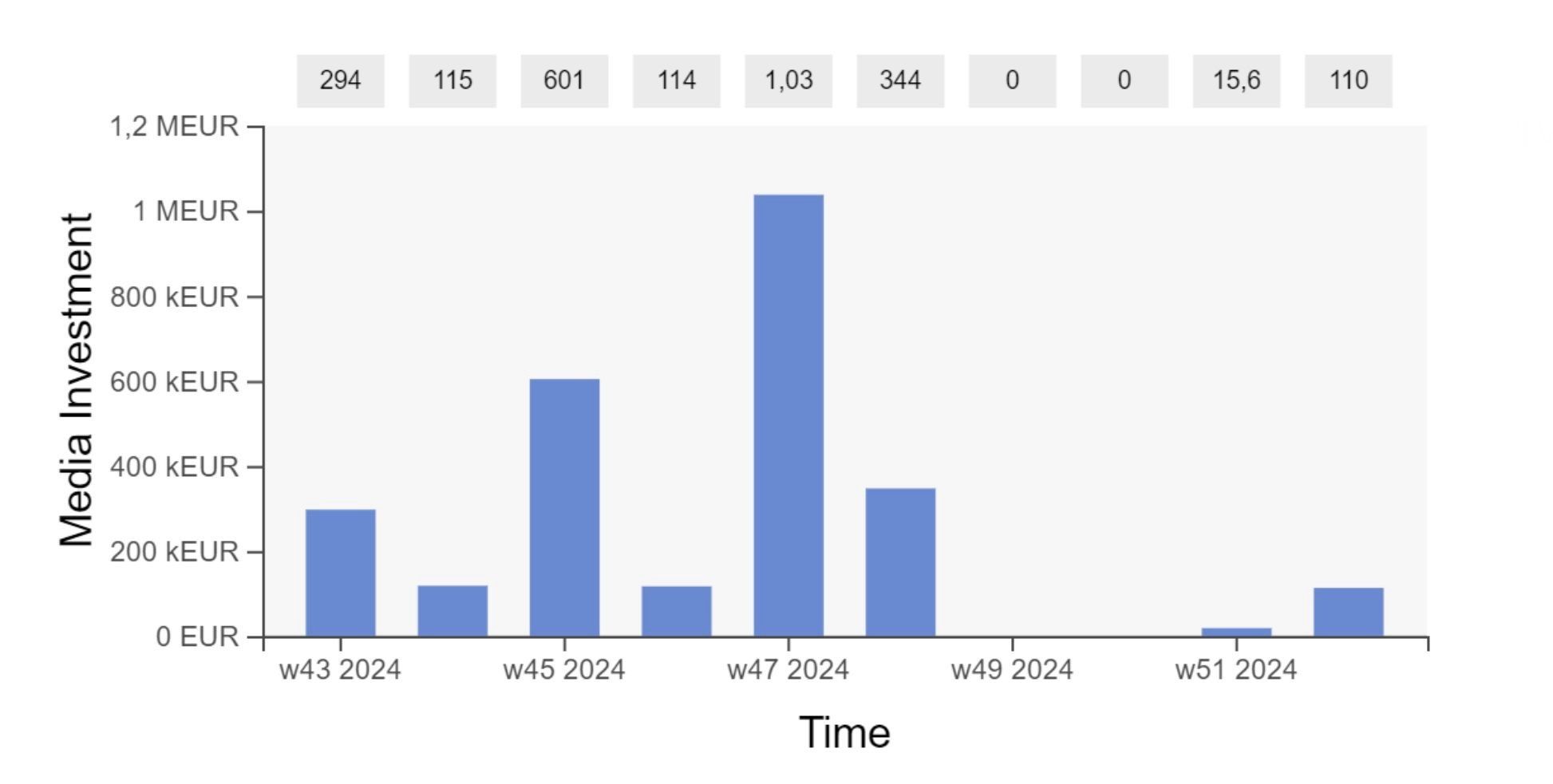
Now we start building competitive scenarios for last year's plan.
Let’s say that now we want to understand what would happen if we only do a 3-week campaign. The Media Optimizer suggests investing closer to Christmas if everything is spent during 3 weeks only.

What if we would do 2 x 3-weeks bursts on pre-selected weeks with lower weekly spend levels?
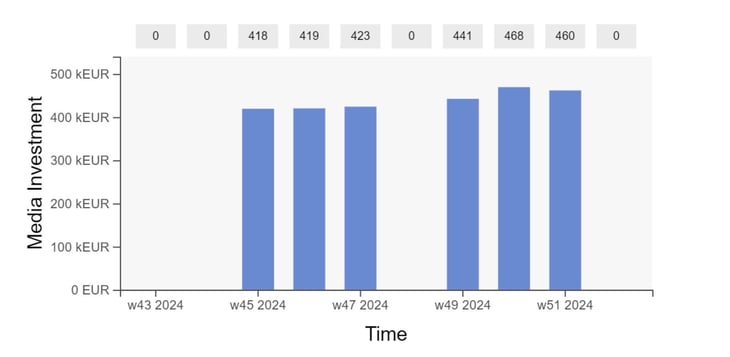
Or, we could do a 6 weeks campaign and let the Media Optimizer choose weeks freely.
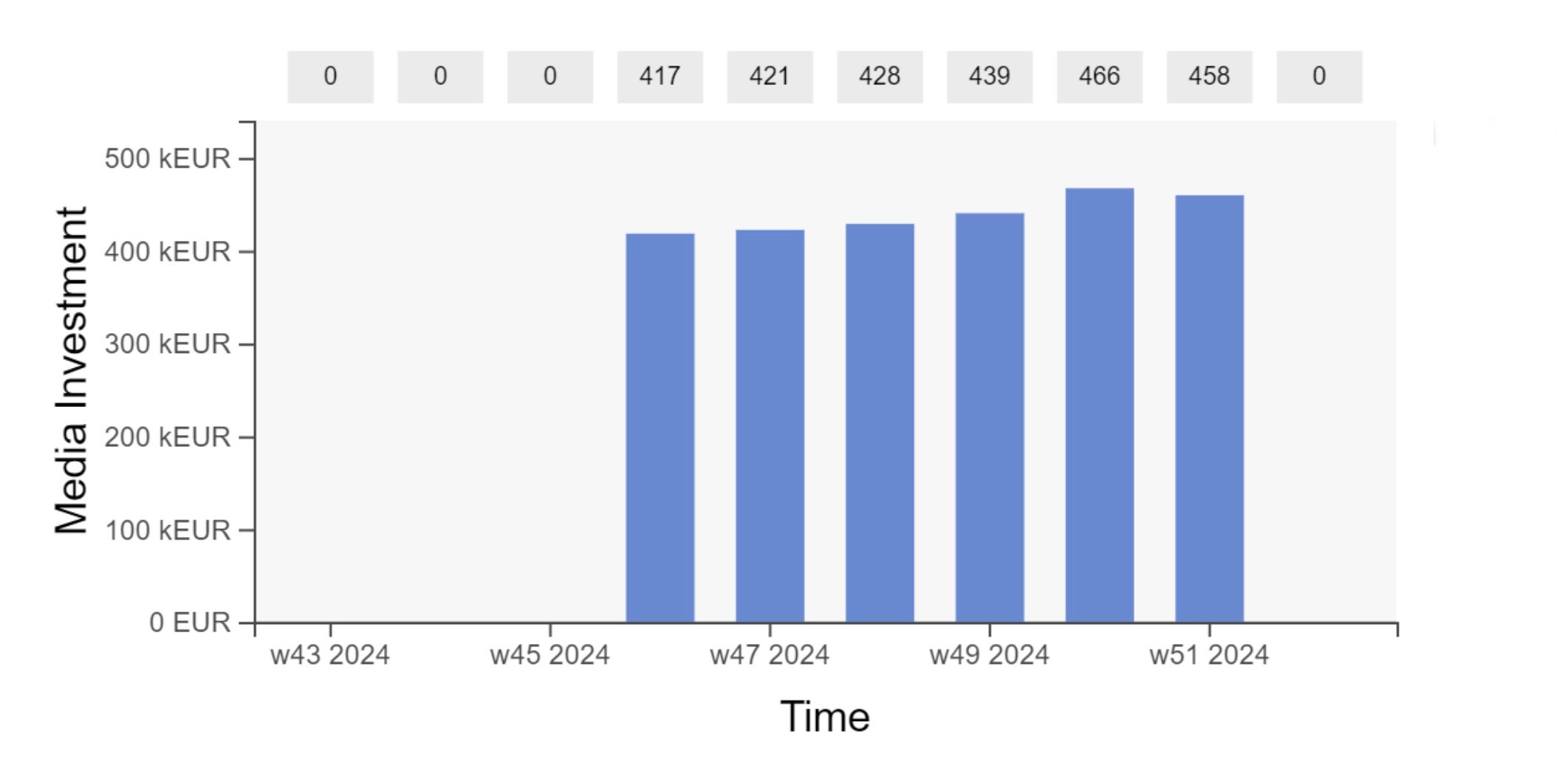
We can also allow the budget to be split across all week (full range).
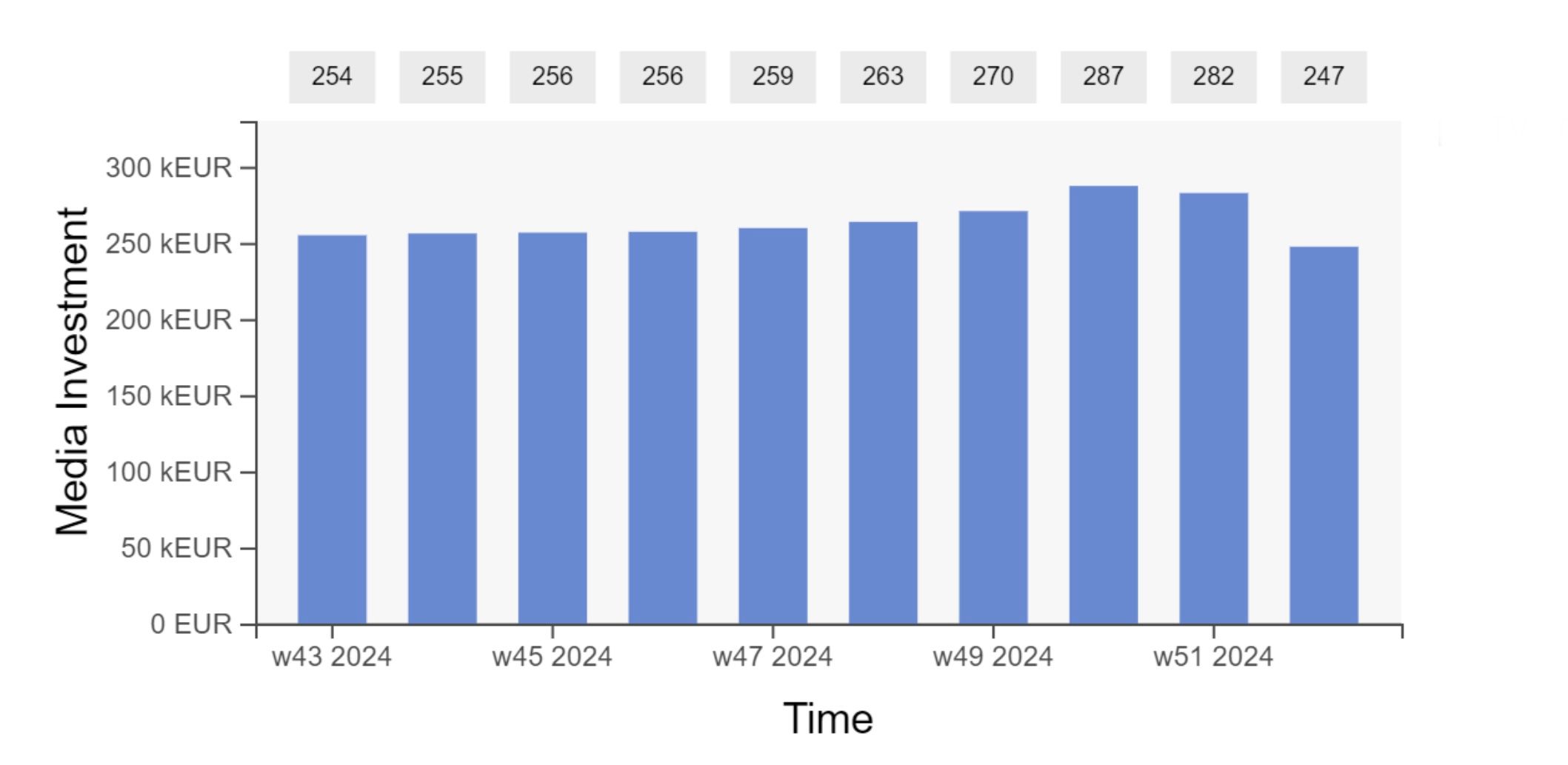
Now, here can we see the potential Incremental Net. Sales from all of the different campaign variations.
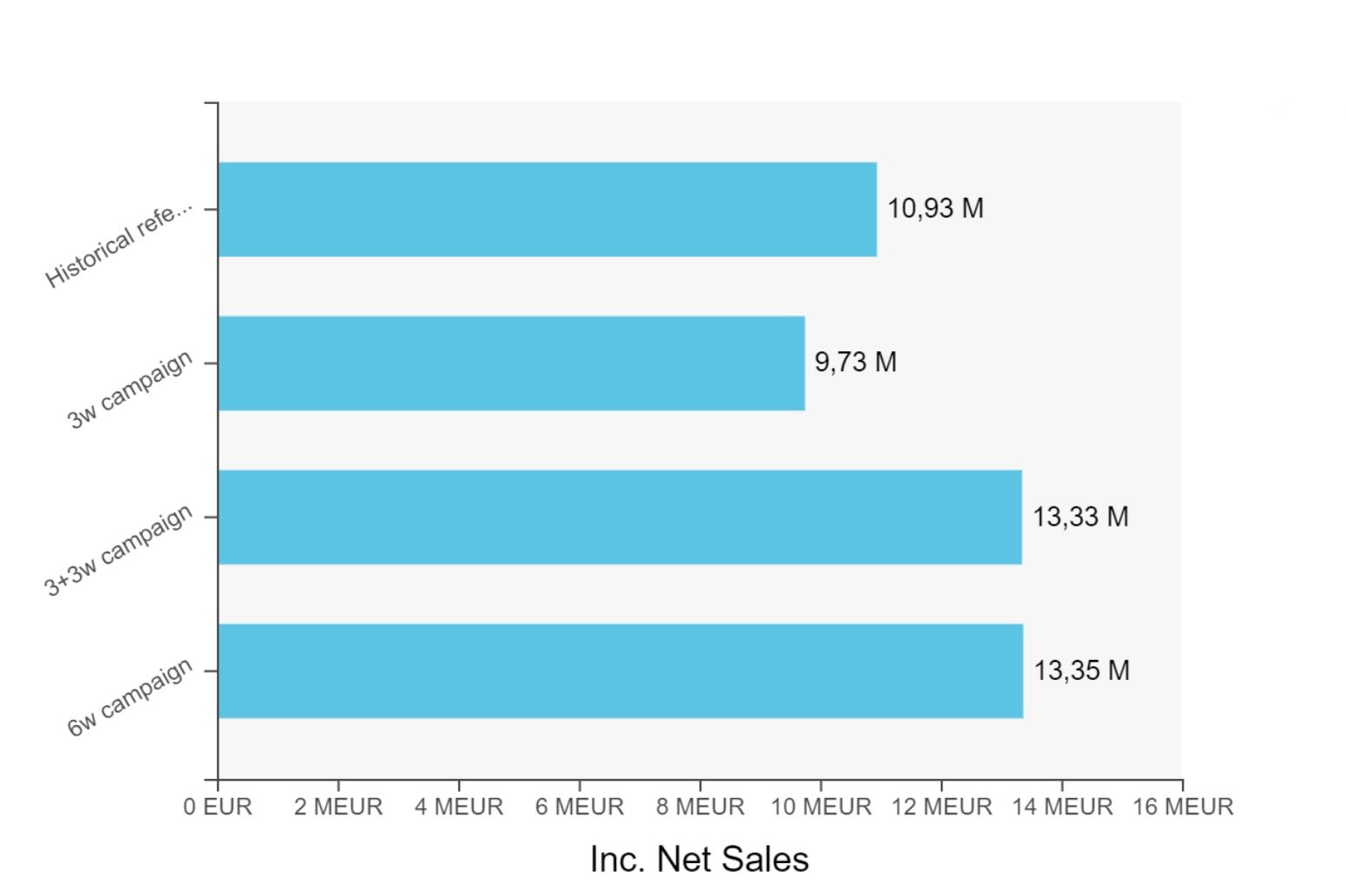
Accordingly we can also check the ROI with all the different timing scenarios created. Based on the results, this customer will get highest return on their investment by being on air for six weeks closer to Christmas.
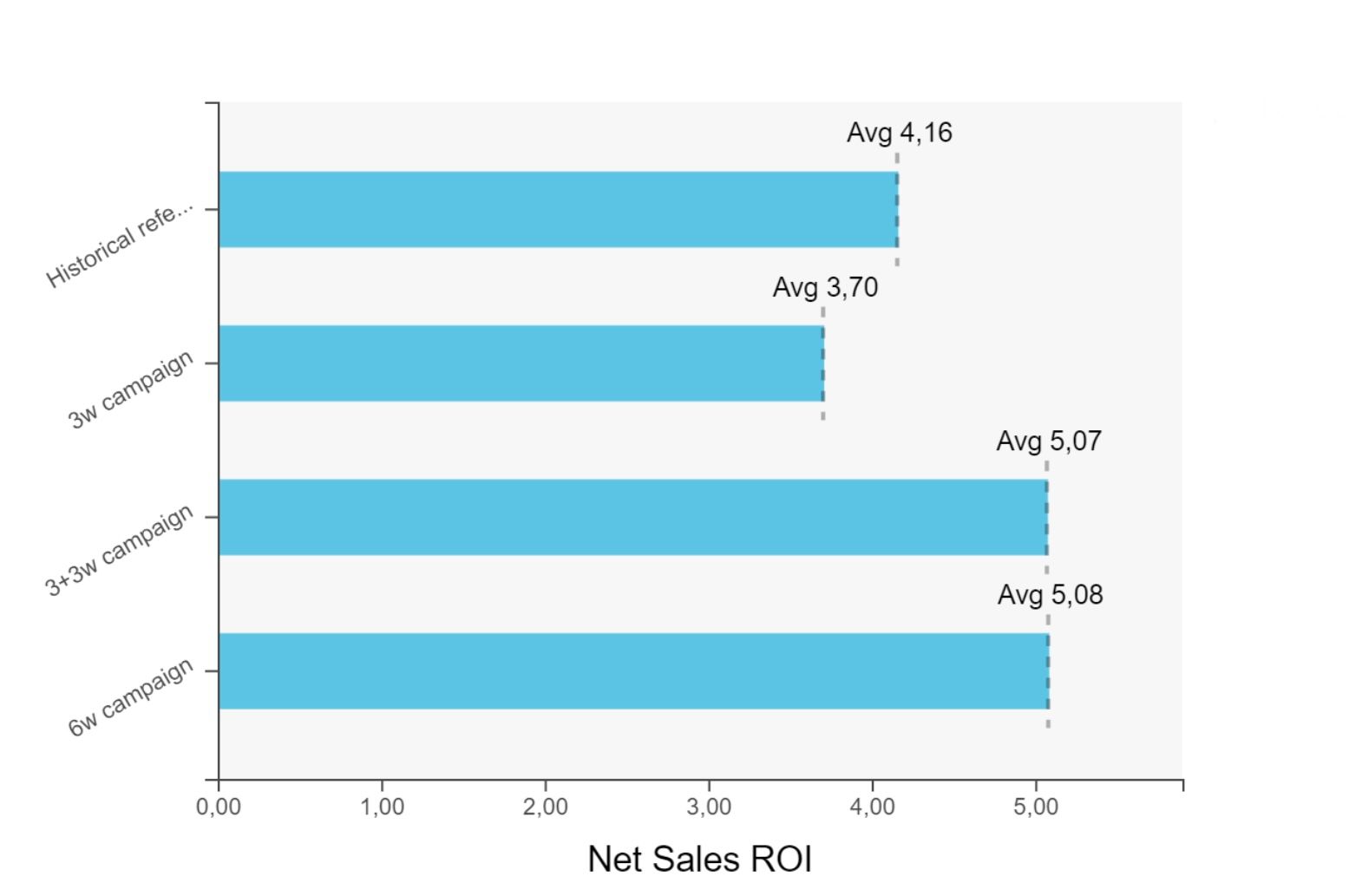
Moreover, we can also look at saturation points so that you can understand when further investment in TV would actually no longer bring any additional ROI. On weekly level you can actually see TV saturation points in the response curves just like any other media channel. Also, we can use the MMM Dashboard to compare daily reach level against the ROI.
Having access to reach and frequency data helps you discover the response curves of TV in MMM. The response curves can help you find the weekly investment levels where the uplift saturates, i.e. the weekly investment level you should not probably exceed.
Conclusively, with the help of the Media Optimizer you can pre-evaluate different campaigns and strategy. Of course, you can also do this with all the media channels, campaigns and your total budget.
How to measure the optimal Radio investment and ROI with MMM?
Measuring Radio ROI with MMM is a similar approach to the one explained previously in the TV section. This is not surprising since many publishers operate with both medium which results in synergies across TV and Radio. You will need the investment data and also information on the campaigns you invested in as well as the radio channels. If you have GRPs available then you could be able to get similar outcomes as the TV analysis. However, the quality and availability of data for radio often lag behind that of TV, making it sometimes challenging to obtain precise metrics. Therefore, Radio MMM analyses tend to rely more heavily on investment data. Even without metrics you can still have a meaningful analysis of radio’s impact on sales.
In the case of Radio, it is important to consider the medium's unique consumption patterns, which can heavily influence campaign performance. For example, the number of radio listeners tends to increase during specific time periods, such as summer holidays, when people are more likely to listen to the radio while on vacation or traveling. Recognizing these seasonal trends can inform strategic decisions about when to invest in Radio to maximize ROI. In these cases, MMM can help advertisers understand the value of seasonal investments in Radio and optimize their media mix accordingly. Essentially, for Radio, and all other media channels actually, MMM not only measures ROI but also guides strategic investment decisions.
How to measure the optimal Out Of Home investment and ROI with MMM?
Measuring the optimal Out Of Home (OOH) investment and ROI with MMM offers a unique challenge, largely because of the nature of OOH advertising itself. Unlike digital or broadcast media, OOH's impact is not as easily quantified through direct metrics like clicks or views. However, OOH remains a strong medium for branding, leveraging high-impact visual displays in strategic locations to capture attention and create memorable brand experiences. An example of its effectiveness are the iconic and witty Netflix billboards on Sunset Boulevard, which highlight that well-executed OOH ads are here to stay.
In the case of OOH, MMM primarily focuses on reach and investment. Reach data, although not as granular as daily metrics, provide a valuable estimate of the audience size over the duration of the campaign. Investment data, serves as a proxy for estimating OOH's contribution to marketing objectives when reach data is not readily available. Our Media Optimizer can help you determine the optimal campaign length and budget allocation for OOH investments.
OOH plays a crucial role in raising brand awareness among new customers and re-engaging existing ones. Through MMM, marketers can gain insights into how OOH fits within the broader marketing mix, helping them to allocate budgets efficiently and maximize the branding impact of their OOH investments. Hence, understanding OOH's role in a multi-channel strategy helps businesses harness its full potential by complementing other media channels and contributing to overall marketing effectiveness.
Why should you measure your offline media with MMM?
It is crucial to include your offline media into the MMM analysis because ignoring offline channels such as TV, radio, and OOH can lead to a disproportionate perception of where and how your marketing budget is making an impact, potentially overemphasizing the role of digital media at the expense of broader brand-building efforts. This imbalance can weaken your brand's strength over time which can lead to a decline in brand recognition and sales.
"Our UI serves as an insights gold mine where you can actually export all the data from the MMM and conduct pretty much every marketing analysis you want to whenever you want to."
Major players like Netflix and Amazon Prime continue to invest in offline media ads, because they recognize the value of reaching demographics less inclined towards digital or subscription-based services. Therefore, do not underestimate the significance of offline advertising in maintaining visibility and relevance across a wider audience spectrum.
Offline media excels especially in brand awareness and loyalty building—which are two key components of the upper marketing funnel. For businesses aiming to increase brand awareness and cultivate a broad audience base, including TV and other offline channels in MMM is not just beneficial but necessary.
We noticed that when businesses use offline media, then their investments in it are actually pretty substantial, meaning that their exclusion from MMM analyses can leave a significant portion of your marketing spend unaccounted for. This can harm your ability to make informed decisions about budget allocation.
We make sure you can get an accurate view of the performance of your offline media investments by making sure that you can update your data regularly (monthly or more often). The offline media investment data is easily mapped using out templates and then incorporated into the MMM analysis.
Ideally, comparing the performance of both offline and online media in MMM will enable marketers to optimize budget allocation across the entire marketing mix for maximum impact.
Tips on starting MMM
- Gather the relevant data: The accuracy of MMM outcomes heavily relies on the quality of input data. Ensure your data on investments, reach, and frequency, among other metrics, is accurate and comprehensive.
- Understand Your Business Goals: Align MMM with your key performance indicators (KPIs), whether that's increasing brand awareness, sales uplift, or customer retention.
- Explore All Media Channels: Don't shy away from channels just because they seem hard to measure; every medium has potential value in your marketing mix.
Curious to learn more? Book a demo.

You May Also Like
These Related Stories

Meta MMM Summit 2022 from MMM SaaS provider's perspective

Sellforte becomes an official Meta Business Partner for Measurement



